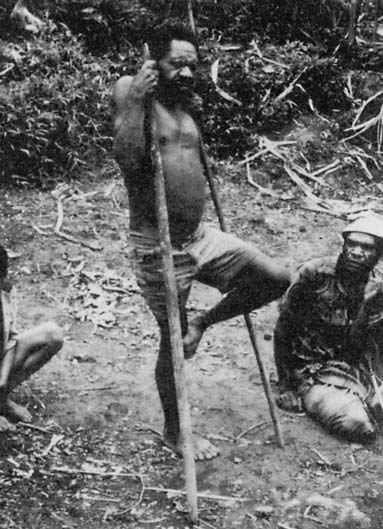
This Article From Issue
November-December 1998
Volume 86, Number 6
DOI: 10.1511/1998.43.0
The Trembling Mountain: A Personal Account of Kuru, Cannibals and Mad Cow Disease. Robert Klitzman. Plenum, 1998. $27.95.
Every word in the subtitle is an irresistible lure: The promise, however, is only partially fulfilled. This book is very much a personal account of kuru and of its mechanism of spread, cannibalism. But there are only a few pages about bovine spongiform encephalopathy, or mad cow disease. That may easily be explained in two ways: There is yet little that can be said about this newest of the prion diseases, and this is not a book of science per se. Robert Klitzman's personal account is not meant to satisfy the biological scientist with new information on any aspect of the subtitle except to convey his discoveries in the field on certain aspects of kuru, or the "trembling," in the language of the Papua New Guinea tribe for whom the disease has been and still may be rampant. The Fore, as highlands cannibals, have long been victims of this frightening malady, and Klitzman tells of his findings in kuru's transmission, symptomology and the primary orientation of this account, its sociology.

From The Trembling Mountain.
Late in Klitzman's undergraduate studies, he had the opportunity of spending time in the laboratory of D. Carleton Gajdusek, later a Nobel laureate for his work on prion disease. Gajdusek's lab was then at the National Institutes of Health's Fort Detrick facility where a number of the planet's most fearful diseases are studied. The most scientifically inclined of the chapters in the book, that on Ft. Detrick, is still very much the personal account of the subtitle. "Carleton," as Klitzman refers to Gajdusek throughout the book, suggested that Klitzman spend a year among the Fore before medical school. Armed with only an undergraduate degree in science, Klitzman took up Gajdusek's challenge to learn about the humans behind the disease. Klitzman's continuing struggle with the cold, clinical nature of medicine versus his own intense sociological bent becomes a major theme throughout the account. We learn only in the closing pages—when he is set to return to the tribe for a revival of memories nearly two decades after his pre-medical school year—that he has become a psychiatrist, apparently seeking the person, not just the parasite.
This personal account is told in a most simple language. The reader may question whether the author is purposely reflecting the "Stone Age" (his term) people whose use of Pidgin English seems as primitive as their actions, or whether this is Klitzman's own style. Given the rather naive tone and the language of the entire book, it seems that Klitzman himself lives in the prose. We learn of seemingly endless trips from his remote village headquarters into the hamlets and villages of the Fore, led by his two tribal guides, who demonstrate what must be innate to these people (and to all humankind, Klitzman wonders): greed. The natives do not come off as the "noble savages" of so many of the West's accounts of primitive peoples. They are devious, self-serving and vengeful. Is this Klitzman's view or reality? It seems to be the latter, for his tales, incidents and anecdotes are rife with the far-from-noble nature of the Fore (and other islanders).
The stories of seeking kuru sufferers and building their genealogies in order to ascertain the epidemiology of the disease are repeatedly unsatisfying to the reader as much as they clearly were to Klitzman in his travels (mostly afoot) in the bush. Many incidents have no conclusion in the text, nor did they in his frustrating real-life adventure. The Fore guides would lead him on daylong walks to see suspected kuru victims only to find that the sufferers were not at home, did not really exist or what? In all of this disappointment, Klitzman was nevertheless able to gather in a year's time enough information (primarily genealogical) about feasting on the dead ("the [Fore's] cemeteries are their stomachs")—the basis for the charge of cannibalism—that the neurological disease kuru could be explained epidemiologically. Only "Carleton," Klitzman and a very few others have spent the time in the Fore's isolated valleys that they can be called experts. So poorly understood is the disease (before the author's initial visit around 1980 and on his return trip only a few years ago) that the hope that kuru may be going extinct is still an open question. Cannibalism has been banned for the better part of a half century, and the cases of kuru all seemed to be in the dying elderly when Klitzman made his discoveries of the transmission mode. Yet, there are still new cases, though very few in number.
The book is an easy read, maybe too easy for someone hungry for more information on the intriguing but elusive prion diseases. It is a frustrating text, yet one is still drawn to read on to see how the young researcher's adventures conclude. In many respects they and the book conclude just as his slogging through calf-deep mud and visits to reformed cannibals do: inconclusively.—Donald J. McGraw, Associate Provost, University of San Diego
American Scientist Comments and Discussion
To discuss our articles or comment on them, please share them and tag American Scientist on social media platforms. Here are links to our profiles on Twitter, Facebook, and LinkedIn.
If we re-share your post, we will moderate comments/discussion following our comments policy.